Angela Ackerman's Blog: Writers Helping Writers, page 43
January 14, 2023
Fear Thesaurus Entry: Criticism
Debilitating fears are a problem for everyone, an unfortunate part of the human experience. Whether they’re a result of learned behavior as a child, are related to a mental health condition, or stem from a past wounding event, these fears influence a character’s behaviors, habits, beliefs, and personality traits. The compulsion to avoid what they fear will drive characters away from certain people, events, and situations and hold them back in life.
In your story, this primary fear (or group of fears) will constantly challenge the goal the character is pursuing, tempting them to retreat, settle, and give up on what they want most. Because this fear must be addressed for them to achieve success, balance, and fulfillment, it plays a pivotal part in both character arc and the overall story.
This thesaurus explores the various fears that might be plaguing your character. Use it to understand and utilize fears to fully develop your characters and steer them through their story arc. Please note that this isn’t a self-diagnosis tool. Fears are common in the real world, and while we may at times share similar tendencies as characters, the entry below is for fiction writing purposes only.
 Fear of Criticism
Fear of CriticismNotes
No one likes to be criticized, but for some people, it can be very intimidating and even demoralizing, leading to an avoidance of any kind of well-intended feedback or critique. A fear like this can also be linked to a fear of rejection. It might be generalized, affecting many areas of life, or be localized to one person or environment.
What It Looks Like
Hesitancy to share their work��
Double- and triple-checking completed tasks
Striving for perfection
Conforming to societal norms
Being highly self-disciplined
The character being very hard on themselves
Asking a lot of questions before starting a new project
Going above and beyond what was asked
Choosing words carefully
Compensating for a perceived inferiority by bragging, exaggerating, etc.
Self-deprecation
Repeatedly apologizing for perceived wrongdoing
Seeking approval and validation��
Being uncomfortable in new environments and activities
Procrastinating or missing deadlines
Never taking initiative
Preferring to be alone
Avoiding risks
Becoming defensive when advice is offered
Avoiding people who might offer feedback
Reading criticism into every instance where advice is given
Taking things personally
Misreading people’s intentions���believing that someone is on a power trip when they’re only trying to help
Not taking advantage of opportunities where criticism is likely
Being unable to differentiate between constructive feedback that should be ignored
Common Internal Struggles
The character always feeling on edge, afraid of making a mistake
Having ideas to share but being too afraid of they not being received
Feeling like a failure
Struggling with low self-esteem
Believing they are inferior or worth less than their peers
Feeling inadequate or incapable
Becoming obsessed with negative feedback
Believing people are waiting for them to make a mistake
Being ashamed of a part of themselves (a physical characteristic, a weakness, etc.)
Flaws That May Emerge
Antisocial, Defensive, Evasive, Haughty, Inhibited, Insecure, Jealous, Know-It-All, Nervous, Perfectionist, Pretentious, Timid, Verbose
Hindrances and Disruptions to the Character’s Life
The character stagnating because they’re unable to accept feedback
Being limited professionally because of an unwillingness to change
Never being able to truly express themselves
Giving up a passion because of criticism in that area
Gaining a reputation for being easily offended, uncooperative, or uninterested in self-improvement
Living with relationship friction due to the character misreading a spouse or parent’s intentions or character (accusing them of being overly critical or believing the other person thinks poorly of the character, etc.)
A lack of self-awareness keeping the character from growing and improving
Scenarios That Might Awaken This Fear
Having to change jobs and start over with a new supervisor
Being put in a situation where the character or their skills are on display
Being assigned a job that is beyond the character’s abilities (being set up to fail)
Being rejected (in an interview, on a date, when sharing an idea, etc.)
Being paired with someone whose performance is always lauded
Receiving harsh criticism from a trusted individual
The character’s skills being brushed aside or devalued
Encountering a loved one whose desire to help looks a lot like criticism
Other Fear Thesaurus entries can be found here.
 Need More Descriptive Help?
Need More Descriptive Help?While this thesaurus is still being developed, the rest of our descriptive collection (16 unique thesauri and growing) is accessible through the One Stop for Writers THESAURUS database.
If you like, swing by and check out the video walkthrough for this site, and then give our Free Trial a spin.
The post Fear Thesaurus Entry: Criticism appeared first on WRITERS HELPING WRITERS��.
January 12, 2023
Writing Insecure Characters
Angela Ackerman and I got our start telling anyone who was interested (and some who weren’t) what we’d learned about the importance of showing a character’s feelings. So I’ll start with a quote from The Emotion Thesaurus about why it’s so important for every author to get this right:

All successful novels, no matter what genre, have one thing in common: emotion. It lies at the core of every character���s decision, action, and word, all of which drive the story. Without emotion, a character���s personal journey is pointless. Stakes cease to exist. The plot line becomes a dry riverbed of meaningless events that no reader will take time to read. Why? Because above all else, readers pick up a book to have an emotional experience.
But they don���t want to be told how a character feels; they want to experience the emotion for themselves. To make this happen, we must ensure that our characters express their feelings in ways that are both recognizable and compelling to read.
How we convey a character’s emotional state is vital to the reader’s experience. They don’t want to be bashed over the head with this information, nor do they appreciate clunky methods that jerk them out of the story. This is where show-don’t-tell comes into play. Show the character’s emotion through their natural responses to it, and readers will figure it out on their own. Use universal responses, and you’ll have the added benefit of readers connecting to the character through a sense of shared experience.
Let me show you what I mean with a universal feeling that should come into play multiple times for your character throughout their story.
Insecurity: No One’s Favorite Feeling
Personally, I’m not a fan of this emotion. It’s uncomfortable, embarrassing, and makes me feel weak. But I love it for my characters because it inherently builds empathy. Every reader on the planet has experienced insecurity���often at crucial moments���and they know how awful it is. Seeing someone they care about stumbling through it tugs at the reader’s heartstrings and makes them root for that character.
Insecurity is also important because it often plays into the character’s arc. Maybe they want to reach for a goal but don’t feel worthy of attaining it. Or they desperately want esteem and recognition from others but they’re too scared of failure to make the effort. Typically, it’s this very insecurity the character will have to overcome if they want to win in the story, so you definitely want to include it.
If your character is going to struggle with this emotion, it’s important to be able to show it clearly. And the best way to do this is for them to respond to it with one of the following tells.
OvercompensationInsecurity is never comfortable. Your character would much rather be seen as confident and capable, so when they’re feeling the opposite, they’re going to try and hide it. One way they might do this is through overcompensating.
We often see this with characters who fit the macho stereotype: bullies, jocks, divas, CEOs, world leaders, etc. For popular examples, look at many of Stephen King’s minor villains, who tend to throw their weight around to hide their weaknesses. Harold Lauder (The Stand) is condescending and off-putting, leaning on his intelligence to overcome his physical shortcomings. Percy Wetmore (The Green Mile) disguises his cowardice and inadequacy by becoming a corrections officer, where he can bully the death-row inmates, who are at his mercy.
Risk-Aversion and AvoidanceOther characters will head the opposite direction, going out of their way to avoid the situations that make them feel unsure of themselves. A good example of this is A Few Good Men’s Daniel Kaffee. He’s grown up in the shadow of his successful father and is convinced he could never compare as a trial lawyer, so he plea-bargains all his cases. This allows him to remain a lawyer without ever stepping foot in a courtroom.
Another avoidance response you might see in an insecure character is the decision not to act. A character with this MO will take a backseat in their own life, letting other people make the important decisions. This way, they don’t have to take responsibility or ownership in the situations that make them feel uncomfortable. Underachievers very often respond this way.
Self-SabotageThe third installment of the Rocky franchise opens with the hero getting completely destroyed by a nobody. This demoralizing defeat, combined with the death of his manager, throws Rocky into a tailspin. When a rematch is declared, he accepts the offer but doesn’t fully commit, allowing himself to be distracted and only go so far in his training. Why? Because he’s convinced he can’t win.
Characters who are afraid of their own insecurities but don’t want to surrender outright may choose to go this route. They might only half-try, or they’ll adopt dysfunctional behaviors that will take them out of the running before they have a chance to fail.
Keeping it RealIt’s important to note that most people aren’t insecure in a general sense; this feeling typically crops up in specific situations. Going back to Daniel Kaffee: you wouldn’t define him as insecure. He’s actually quite confident���personable and charming, lots of friends, an athlete, with a respectable job as a lawyer. It’s only in certain scenarios that his self-doubt comes through.��
This is a much more realistic picture of insecurity; it’s situational. Make sure your characters are well-rounded by giving them skills and strengths, areas in which they excel. Then, when they’re facing a challenge that makes them feel small and incapable, the contrast in their response will show readers what’s up.
Fight, Flight, or Freeze?One last thing to note about this emotion: how your character responds to insecurity will depend on their fight, flight, or freeze response. If they tend toward fighting, they’ll likely become more aggressive, overcompensating for whatever failing (perceived or real) they’re trying to hide. A character who is more likely to flee or freeze will have an avoidance or self-sabotage response as they try to escape the threatening situation. So definitely do your homework in this area, because knowing your character’s natural tendency will give you a good idea of how they’ll respond when insecurity crops up.
The post Writing Insecure Characters appeared first on WRITERS HELPING WRITERS��.
January 10, 2023
An Unbreakable Promise to Readers
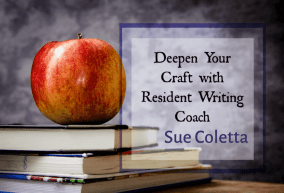
A novel���s opening chapter makes a promise, a secret vow that says, ���This is what you can expect from me.���
The chapters that follow better fulfill that promise, or the author will suffer the consequences with low-ratings, bad reviews, or their name on the Don���t Not Read list.

Yes, the promise is that important. It���s how we build and maintain an audience. It���s how we climb the proverbial ladder of success. It���s how we keep readers hungering for more.
This solemn vow can NEVER be broken.
None of my recent reads landed within my preferred genres of psychological thrillers, dark & gritty mysteries, and serial killer thrillers, but I feel it���s important for writers to venture outside their genres from time to time.
For my next read, I wavered between WIN by Harlen Coben or Book 2 of a serial killer thriller series from one of my auto-buy authors. I devoured Book 1 in a couple days, and I���d been dying to read Book 2 for a while now, so I bought the $9.99 ebook. Immediately, the author transported me to a serial killer���s lair with the protagonist bound and helpless. I was enthralled. As I said, I���d been looking forward to this novel for a while and the opener didn���t disappoint.
Without sharing the title, I���ll show you how the writer sucked me into the scene.
Darkness.
It swirled around him deep and thick, eating the light and leaving nothing behind but an inky void. A fog choked his thoughts���the words tried to come together, tried to form a cohesive sentence, to find meaning, but the moment they seemed close, they were swallowed up and gone, replaced by a growing sense of dread, a feeling of heaviness���his body sinking into the murky depths of a long-forgotten body of water.
Moist scent.
Mildew.
Damp.
[Protagonist] wanted to open his eyes.
Had to open his eyes.
They fought him though, held tight.
His head ached, throbbed.
A pulsing pain behind his right ear���at his temple too.
���Try not to move, [Protagonist���s name]. Wouldn���t want you to get sick.���
The voice was distant, muffled, familiar.
[Protagonist] was lying down.
Cold steel beneath the tips of his fingers.
He remembered the shot then. A needle at the base of his neck, a quick stab, cold liquid rushing under his skin into the muscle, then���
Gripping, tense, love the story rhythm, the way he pauses at just the right moment. I could not flip the pages fast enough. Lovin��� every second of it!
And then���
In the next chapter, I find out it was all a dream. Infuriated, I almost whipped my Kindle across the room. One of my auto-buy authors wrote this thriller, and I expected him to fulfill the promise he made to me. Instead, he cheated. I was so disappointed, I refused to keep reading. He���d broken my trust. He let me down.
Sounds harsh, doesn���t it? But that���s exactly how I felt.
The emptiness he inflicted left me hungering for a visceral, gritty, serial killer thriller, one that would fulfill its promise.
I downloaded thriller number two.
Without revealing the title or author, here���s a small sampling of that opener.
I woke up from a gentle shake. My sister���s face hovered a few inches above mine, her eyes glistening wet. A grinding sound came from her jaw as it moved back and forth.
I shivered.
[Sister] put her fingers against my lips. ���SSSH. Nod if you understand,��� she whispered.
I nodded.
My room was freezing from the cold wind blowing in through my open window.
���The monsters are coming for us. Be very quiet. We���re escaping,��� she whispered.
I nodded again, biting my lip hard to not cry.
Was there a monster in my closet? Behind my closed bedroom door?
My heart thrashed against my ribs like a bird trying to escape its cage. Why were the monsters after us?
We learn the protagonist is a child and her older sister is rescuing her from an imminent threat. Other than a few writing tics, like SSSH instead of Shh���, the author did a terrific job of showing the action. Finally, I could sink into a gripping read. Or so I thought.
The next chapter (Ch. 1) consisted of pages and pages of backstory. No plot, only backstory. The premise still intrigued me, so I kept reading. Then I hit a flashback that dragged on for several pages. The worst part? It added nothing to the main storyline.
Still, because the prologue was so good, I read on. The prologue had raised many, many story questions, and I wanted answers. But in Chapter 2, I read more pages of backstory andanother flashback. The next chapter was equally disappointing, with more pages of backstory and a third (fourth?) flashback. I lost count.
Whiplashed from being thrown forward, then backward, I couldn���t take it anymore and closed the book.
A good premise will only take you so far. At some point, you need to deliver on the promise you made to the reader.The third novel I bought���all in same day, I might add���began with a slow burn opener. A girl is emptying a bucket of oil into the dumpster behind Burger King. It doesn���t sound like much on the surface, but the co-authors held my interest. Which, after being burned twice in a matter of hours, wasn���t an easy task.
Here���s the opening of DEAD END GIRL by L.T. Vargus & Tim McBain:
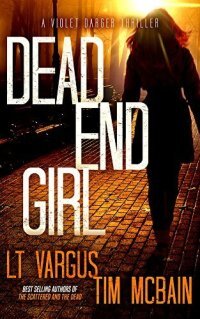
Corduroy pants swished between Teresa���s thighs as she crossed the parking lot. She had a headache. That drive-thru headset gave her a headache every damn time. The band squeezed her skull like an old man trying to find a ripe cantaloupe in the produce department. Pressing and pressing until her temples throbbed. When the headaches were really bad, she got the aura. And it was gonna be a bad one tonight. She could already tell.
By the time she got home, she���d be nauseous from the skull throb along with the stink of fryer grease clinging to her clothes and hair and skin. Sometimes she swore she could feel it permeating her pores.
She placed a hand under the lid of the dumpster and lifted. The overhead lights in the parking lot glinted on the surface below. It looked like water, but it wasn���t. It was oil. Every night they emptied the fryers, dumping the used oil into this dumpster. It was a disgusting task. Worse than taking out the trash on a 90-degree summer day, when the flies got real thick, and the meat went rancid almost as soon as they put it in the bin.
It was dead out. No traffic. No noise at all but her fiddling with the dumpster and the bucket.
Her skin crawled a little whenever she was out here this late. In the dark. In the quiet. A feeling settled into the flesh on her back and shoulders, a cold feeling, a feeling like after watching one of those scary movies when she was a teenager. It might have been a thrill while she was watching, but later on that night she���d always get spooked. She���d tremble in bed, too terrified to walk down the hall to pee. The house never seemed so ominously still as it did on those nights. Anyhow, she couldn���t stand to watch horror movies anymore. Her weak stomach couldn���t handle the gore.
Bending over the metal cart she���d wheeled along with her, Teresa scooped one of the buckets of used fryer oil and balanced it on the edge of the dumpster. She tipped the bucket and watched as the gallons of brown grease oozed into the dumpster, disrupting the smoothness.
Settled at the bottom of the bucket, there were clumps and chunks. Burned bits of fries and chicken tender crumbs. They splatted and splashed into the pool of liquid that looked black in the night.
That���s when Teresa saw it. Something rising out of the oil, disturbing the otherwise unblemished surface.
Intriguing, right? Most importantly, the authors kept their promise. Elated, I could not flip pages fast enough, savoring favorite passages, the story rhythm, and pitch-perfect pacing.
Come morning, I felt bad about dissin��� my auto-buy author. Maybe he had a reason to break the don���t-open-with-a-dream rule.Could the last line of the first paragraph indicate a dream?
���his body sinking into the murky depths of a long-forgotten body of water.
In hindsight, maybe. Probably. But it���s too subtle. Nonetheless, I grabbed my Kindle and kept reading. Sure enough, he used the dream sequence to show how it affected the protagonist, who���s been suffering nightmares after a serial killer slipped through his grasp. The dream relates to the plot because that serial killer is back.
Do I agree with the dream opening? No, but I kept reading because I knew this author delivers each and every time and his writing speaks to me. But what if I wasn���t a fan? What if I���d chosen the book at random? He would���ve lost me. See what I���m sayin���? It���s a risky move.
We spend a lot of time perfecting our opening pages, polishing them till they shine, but our job doesn���t end there. We must follow through in subsequent chapters by setting up scenes, paying them off, setting up more, paying off more.
Other than that crucial promise, your solemn vow to the reader, a few other takeaways are���Don���t start with a dream sequence unless the reader knows it���s a dream AND you���ve got a damn good reason to do it.Go easy with backstory. Sprinkle it in over time.Avoid flashbacks unless they���re absolutely necessary. Most times, they���re not.Don���t tell the reader what happened in the past. Trust us to figure it out on our own.A great premise only works if you deliver on that promise.If a slow burn opener works for your story, use it. Every novel doesn���t need a lightning-fast opener to draw and hold interest.How far do you read before DNFing a book?The post An Unbreakable Promise to Readers appeared first on WRITERS HELPING WRITERS��.
January 7, 2023
Fear Thesaurus: Being a Burden to Others
Debilitating fears are a problem for everyone, an unfortunate part of the human experience. Whether they’re a result of learned behavior as a child, are related to a mental health condition, or stem from a past wounding event, these fears influence a character’s behaviors, habits, beliefs, and personality traits. The compulsion to avoid what they fear will drive characters away from certain people, events, and situations and hold them back in life.
In your story, this primary fear (or group of fears) will constantly challenge the goal the character is pursuing, tempting them to retreat, settle, and give up on what they want most. Because this fear must be addressed for them to achieve success, balance, and fulfillment, it plays a pivotal part in both character arc and the overall story.
This thesaurus explores the various fears that might be plaguing your character. Use it to understand and utilize fears to fully develop your characters and steer them through their story arc. Please note that this isn’t a self-diagnosis tool. Fears are common in the real world, and while we may at times share similar tendencies as characters, the entry below is for fiction writing purposes only.
 The Fear of Being a Burden to Others
The Fear of Being a Burden to OthersNotes
A character who doesn’t want to put their needs���emotional, mental, physical, etc.���on others can develop a fear of becoming a burden to the people in their lives. This can become problematic when the character needs help but doesn’t seek or accept it, or when they shut themselves off from everyone else, trying to be completely self-reliant.
What It Looks Like
Valuing autonomy and independence
Being a hard worker
The character doing things themselves instead of asking for help
Always putting on a happy face; downplaying their own difficulties
Rejecting monetary gifts
Helping others in need but not accepting help for themselves
Always paying their own way (for a meal, clothing, college tuition, etc.)
Appearing private or standoffish
Cleaning up after themselves (washing their own dishes, throwing away trash, etc.)
Declining assistance for projects or tasks
Being a caretaker for younger siblings or friends
Putting other people’s needs before their own
Only letting people get so close; keeping them at an emotional distance
Hiding illnesses, injuries, financial difficulties, etc., from others
Looking ahead and planning carefully so the character’s affairs are in order and they won’t be a burden to others
Being a difficult patient
Common Internal Struggles
Always being burdened with a heavy weight of responsibility
Needing help but not being able to ask for it
Struggling with perfectionism
Feeling isolated��
Feeling worthless or like a failure if they need help from others
Fearing growing old and losing autonomy
Thinking unkindly of people who do rely on others
Flaws That May Emerge
Dishonest, Inhibited, Perfectionist, Stubborn, Subservient, Uncommunicative, Uncooperative
Hindrances and Disruptions to the Character’s Life
Having to deal with difficulties on their own
Being viewed by others as stubborn and difficult
Trading companionship and community for self-reliance
Burning out emotionally or physically
Suffering an injury or breakdown and having no one to help
Suffering needlessly because the character refused to accept help
Scenarios That Might Awaken This Fear
The character going through something traumatic with no one to support them
Developing a condition that requires a caretaker
Aging and requiring support from loved ones
Falling on hard times and having to accept charity
A conversation with a friend that provides an opportunity for the character to share something emotionally heavy
Seeing someone who was strong and resilient having to be cared for by others
An event that threatens the character’s financial security (being laid off, making a bad investment, being scammed, etc.)
Other Fear Thesaurus entries can be found here.
 Need More Descriptive Help?
Need More Descriptive Help?While this thesaurus is still being developed, the rest of our descriptive collection (16 unique thesauri and growing) is accessible through the One Stop for Writers THESAURUS database.
If you like, swing by and check out the video walkthrough for this site, and then give our Free Trial a spin.
The post Fear Thesaurus: Being a Burden to Others appeared first on WRITERS HELPING WRITERS��.
January 5, 2023
5 Reasons Why It���s Still a Good Idea for Writers to Have a Blog
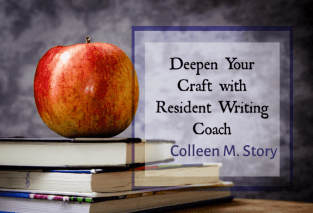
It���s 2023. Should writers have a blog?
It’s been the subject of debate for several years now. There was a time when, if you intended to publish and sell books, you were expected to write a blog too.
But it���s not so clear-cut today. There are a lot of ways to communicate with your potential readers, and blogging is only one of them.
Here are five reasons why I think it���s still one of the best.
1. Blogging Gives You Something to Talk About Besides ���Buy My Book!���Whatever online platform you���re on, you need something to talk about. You have your book(s) of course, but what else? Maybe you talk about your pets, your daily walks, your traveling adventures, or your culinary talents.
Some writers can manage this well, providing consistent entertaining content for their followers, but for others, the ���What do I talk about now?��� question comes up pretty quickly.
If you have a blog covering a topic you’re passionate about, you don’t have that problem. I’ve been managing my blog, Writing and Wellness, for eight years now, and I’ve yet to come up against any serious struggles when it comes to thinking up topics. (If you have a blog and you are struggling with this, you may not have found your perfect niche.)
Anytime you write a blog, you have a great source of information to share on all your other social platforms. That can be a lot easier than asking your cat to pose for the hundredth time.
2. Blogging Helps Attract New Visitors to Your Website
Yes, you can post pictures and text on your choice of social platforms, but will that draw readers back to your website?
You may not think that���s necessary. But how else can you introduce your reader to your work, or lure them into signing up for your newsletter?
Sure, you can ask people to subscribe on your Twitter or Facebook pages, but if all they have to review are your posts on those platforms, they are less likely to sign up than if you lure them back to your website where you have a juicy freebie to offer them.
Yes, you can offer freebies on other platforms too, but the point is that there are more limitations in design and presentation on these sites than there are on your website.
And then what if your social media platform of choice changes the rules? Suddenly you may not be able to reach some of your readers as well. Your website, on the other hand, remains strictly under your control no matter what.
People need to get to know you and believe you have something of value to give them before they���ll sign up for your newsletter. Everyone is more reluctant to give out their emails today than even a year ago. They���ll look for an excuse not to sign up, so it���s more important than ever that you make the idea enticing.
Having a blog that you regularly update with new information can keep a reader coming back again and again until they finally succumb to that tempting offer and join your list.
3. Blogging Helps You Become an Expert at Your NicheWhen you find the right niche for your blog, you can then write about that niche over and over again. As you do, you���ll find yourself becoming the expert in your readers��� minds, which will only broaden your reach.
Let���s say you���re a romance writer who writes about the perfect vacation spots for couples on a budget. Do that for a couple of years and you���re soon to become the expert on it. Your site will be the one people come to for information when they want to find a unique, affordable romantic getaway.
If you do it right���post regularly (once a week at the very least) and follow SEO recommendations���you may soon find that Google is helping to send people your way when they search for topics you cover. Hello, new readers!
4. Blogging Can Open Up New Possibilities for Your Writing CareerDon���t be surprised if the more you blog, the more opportunities open up for you in your writing career.
My blog, for example, is the reason I���ve written three (so far) nonfiction books for writers. I never imagined I���d write and publish nonfiction books until after I���d been writing my blog for a while. I soon realized that writers needed more information on the topics I was writing about, and I could give it to them in the form of a book.

Now I���m both a novelist and a nonfiction writer.
I���ve also received several invitations to speak at writing conferences completely because of my blog���it���s helped establish me as an expert in my niche, and increased awareness of what I have to offer.
5. Blogging Gives You a Reliable Home BaseWe all know that the writing life has its share of ups and downs. It can get tough at times, and if your books are all you have, you can feel easily discouraged.
If you have a blog too, however, it gives you a kind of ���home base��� you can return to no matter what happens with each book launch, or with anything else in life for that matter.
One of the writers I interviewed on my site shared how her blog became her writing refuge while she was battling a difficult illness. She didn���t have the energy to write another book, but she could continue to communicate with her readers and subscribers through her blog. She said it sustained her until she became well enough to write a book once again.
The market can be fickle, but a blog can give you a reliable conduit to your readers no matter what happens. Positive feedback from those readers can also be a lifeline when you���re going through a rough time.
Bottom line: A blog can give you a welcome outlet for your creativity even when you may not be up to writing another book for whatever reason.
And any kind of consistency in a writer���s life can be a great thing!
Pssst: Mindy here to say that a great way to draw people to your blog is to share an amazing guest post at a popular blog. Check out the Guest Post Guidelines at Writers Helping Writers. I hope I’ll see some incredible post proposals from our readers. 
*Keep your eyes open for Colleen’s April post full of tips for making your blog successful.
Note: Need help setting your goals for the New Year? Check out Colleen���s FREE report here. It includes 7 questions you can ask yourself to determine what goals will work best for you.
The post 5 Reasons Why It���s Still a Good Idea for Writers to Have a Blog appeared first on WRITERS HELPING WRITERS��.
January 3, 2023
Force Your Character to Make Hard Choices

One of the best things about conflict is that it pushes your characters to act. In every scene, your characters are making choices���big ones and small ones, and thereby steering their fate. Some decisions will be obvious and require little to no thought, but others will be muddier, with no clear ���better��� option, generating inner conflict. These choices, provided the characters feel personally invested in the decision, act as a test, revealing who they are.
Finding ways to naturally characterize our characters is gold in storytelling, so making the most of a character���s decisions is a wise move. But when we make choices a bit more complex, they go beyond black-and-white options, which creates tension and potentially painful consequences.
9 Types of DecisionsYour Characters May Have to Make
Let���s look at the types of quandaries that can make decision-making easier��� or much more difficult.
1. MinorThese choices will be relatively simple, and the consequences won���t have much impact. Examples include decisions about what to order off a menu, which outfit to wear to the office, or whether to make an appointment now or later.
2. Win-WinThis is the one every character wants but rarely gets, because ��� writers are evil, and all that. A win-win means both options are good. Either way, the character comes out ahead and anyone impacted by the choice will be happy with the outcome. Win-wins are conflict killers, so if you use one, make sure it comes with some unforeseen price tag attached to it.
3. Win-Lose
These choices appear obvious; one is a good option, the other is not. It means someone will be happy and someone won���t, and this might be okay depending on who is on which end of the stick. For example, if the choice means your protagonist gets what he wants and his rival doesn���t, well, that���s the perfect happily-ever-after. But this scenario can be a hard one if the character has a close relationship with the person who loses. Consider your character���s anguish if he and his friend have both been poisoned, and there���s only one dose of the antidote. If he takes it, it means his friend will die. That���s a hard choice to make.
4. DilemmasWhen neither choice is ideal, you have a dilemma. Decision-making can require a lot of weighing and measuring, because no matter what choice is made, there will be blood. These choices often come down to what the character is willing to sacrifice and for how long. Preferences will also factor into the choice. Would the protagonist rather lose time or money? Should she admit the truth and suffer ridicule for a short time, or drag it out with denials that everyone will see through anyway?
5. Hobson���s ChoiceHave you ever been offered something you don���t really want, but maybe it���s slightly better than nothing? That���s a Hobson���s choice. An example would be applying for a promotion and instead being given the choice of a deep pay cut or being laid off.
6. Sophie���s ChoiceThis scenario is one in which the character must choose between two equally horrible options. Named for the book (and movie) Sophie���s Choice, in which the character must decide which of her two children will be killed, this is known as the impossible, tragic choice. However, it can also simply be a time-and-place decision in which the character can only be in one place at that time. And the ramifications don���t have to be catastrophic. They can be minor���as in the case of the character being able to attend his own college graduation or his grandmother���s 100th birthday party. Regardless of the decision, guilt will accompany the character���s choice in this kind of scenario.
7. Morton���s Fork
This choice is agonizing because both options lead to the same end. It���s Max (Mad Max) handcuffing Johnny the Boy to a gas tanker that has a time-delay fuse and handing him a hacksaw. Dying from the explosion or the loss of blood from cutting off his own ankle ��� it���s a deceptive choice because there is only one outcome.
8. Moral ChoicesMoral choices (Sophie���s Choice is one kind) are those requiring the character to decide between two competing beliefs or to choose whether or not to follow a moral conviction. Does she tell the truth because honesty matters���even when it will deeply hurt someone? Protect a loved one or turn him over to the police? Use an advantage to get ahead, knowing it would be wrong to do so? Moral choices require the character to rationalize the decision so she can feel okay about making it.
9. Do Something or NothingIn some cases, the character can choose whether to intervene or not get involved. He may not be personally impacted by the outcome either way, or there might be a cost: a risk to his reputation (if not acting paints him as a coward), the moral repercussions of deciding to do nothing (after, say, letting someone die), or even a safety cost (if he chooses to save someone who turns out to be a threat).
***
Whatever choices you weave into the story, find ways to create inner conflict. One method is to pair options that are equal in some way, such as choices that represent two fears, two needs, or two types of risks or sacrifices. You can also focus on elements that are in direct opposition to each other, such as pitting a fear against a need, duty against freedom, or a want against a moral belief. Conflicting emotions, especially the big ones, can also be used to give readers a front-row seat to a meaningful inner struggle.
Once the decision is made, the psychological turmoil can continue in the form of doubt and second guesses. Were the character���s motives pure? Should someone else have made the decision? A choice���s fallout, especially when the consequences negatively impact others, will add still more weight to the character���s burden of guilt and regret. And the closer she is to those impacted by the choice, the worse the fallout will be.
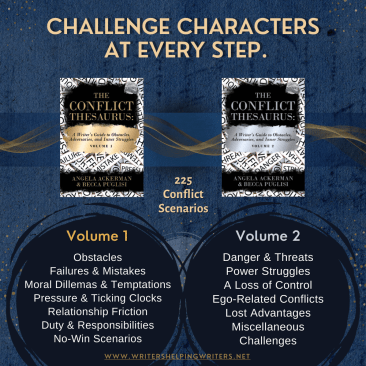 Brainstorming Conflict &
Brainstorming Conflict & Using It Effectively
If you���d like an arsenal of conflict ideas at your fingertips, consider picking up The Conflict Thesaurus: A Writer���s Guide to Obstacles, Adversaries, and Inner Struggles Volume 1 & 2. This book pair will provide you with endless ideas for story friction, and guide you to all the ways you can use conflict to power your story���s plot and character arcs.
The post Force Your Character to Make Hard Choices appeared first on WRITERS HELPING WRITERS��.
December 22, 2022
Happy Holidays & Our Favorite Recipes

Angela, Becca and I hope you���re having an amazing holiday season full of family, friends, good food and special memories. We are so grateful for your visits, kind words of support, and trust in us. We love serving the writing community through this blog, One Stop for Writers, books, and teaching.
We���re tucking Writers Helping Writers in for a well-earned rest until 2023. But we want to make sure you have plenty to read during our break���so we���ll leave you with delicious recipes to try and lots of helpful posts to browse.
Check Out the Wealth of Information onWriters Helping Writers
Writing Tools
Checklists and Tip Sheets
First Page Resources
Characters
Plot and Structure
Worldbuilding and Setting
Show-Don���t-Tell
Other Story Elements (including theme and symbolism, point of view, voice, pacing, dialogue, etc.)
Revisions and Editing
Creativity & Mindset
Business of Writing
Resident Writing Coach posts
Favorite Recipe to You
We can���t wait to find out what you think of some of our favorite recipes! You���re welcome to share some of your own, too. It���s always fun to test out new recipes. 
 Becca���s Recipe
Becca���s Recipe
 Mindy���s Recipe
Mindy���s Recipe
 Paying it Forward
Paying it ForwardOne of my favorite things about Angela and Becca is how much they do to help others. They���ve always had a pay it forward mentality, which is why this site is loaded with free tools, downloads, and resources. But helping beyond the writing community is something they believe in as well. As a way to celebrate the release of the SILVER Edition of The Conflict Thesaurus: A Writer���s Guide to Obstacles, Adversaries, and Inner Struggles, they awarded matching cash prizes for the 1st and 2nd place winners of their Writer���s Fight Club Story Contest to charities that help those impacted by conflict. Plus, each year they select a specific charity (or two) and donate a portion of their book revenue to it.
Here���s the 2022 Recipient
With the war in Ukraine, everyday people are enduring extreme challenges and hardship that takes a mental and physical toll. This year, Angela and Becca are sending $1000 to the��International Medical Corps��to helps this organization continue to supply lifesaving mental and medical support to Ukrainians who are in desperate need.
This is only possible through your generosity, so know when you buy books, subscribe to One Stop for Writers, or attend a workshop, you are an important link in the chain.
Thank you for helping to make the world a better place.
Happy holidays!We���d love to know if there are topics you���d like
us to cover in 2023.

The post Happy Holidays & Our Favorite Recipes appeared first on WRITERS HELPING WRITERS��.
December 19, 2022
Writers, Have You Watched This Free Webinar on Reader Engagement?
Hi lovely folks! We know that the clock is ticking down to the holidays, and it’s easy to lose track of everything, so Becca and I wanted to remind you about our gift to you: a free recorded webinar on how to leverage psychology & the show-don’t-tell mindset to hook readers & keep them engaged.
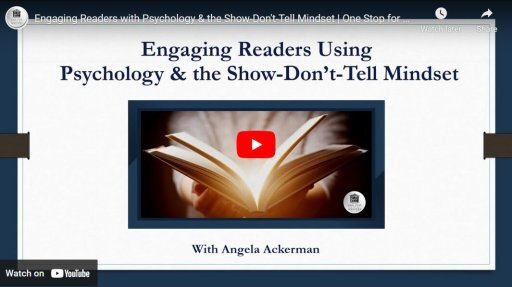
This 40-minute recording is packed with great takeaways, and gives you a window into how Becca and I think when it comes to characters, psychology, and making sure only the strongest details make it to the page. It will be available until January 8th, so we hope you get a moment before then to watch it!
Need a Last Minute Gift?We hope you’ll consider one of our bestselling thesaurus guides, or a One Stop for Writers gift certificate. We love helping writers, and your support allows us to keep doing that, so thank you!
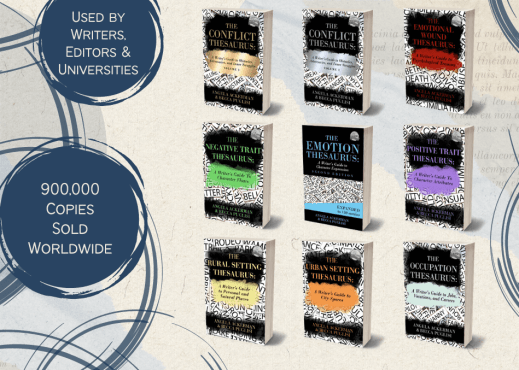 Strengthen Your Description for Stronger Characters & Scenes
Strengthen Your Description for Stronger Characters & ScenesEach guide focuses on a specific topic, educates you on how to best use it in your story, and provides you with brainstorming lists to help you describe it with authority. (To see a sample from each book, download our free Show-Don’t-Tell Pro Pack.)
Available in Print, Ebook, and PDF.
VISIT OUR BOOKSTORE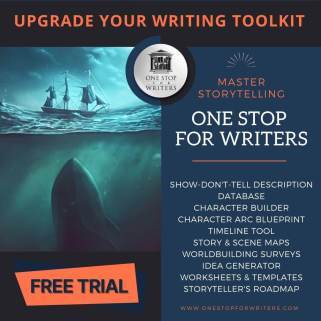 Everything You Need to Create In One Place
Everything You Need to Create In One PlaceBecome a powerful storyteller with One Stop for Writers! Angela & Becca have built you the largest show-don’t-tell Thesaurus Database anywhere, intuitive tools to make story planning easier, a Storyteller’s Roadmap that guides you step-by-step as you plan, write, and revise, & much more.
Visit One Stop for WritersThe post Writers, Have You Watched This Free Webinar on Reader Engagement? appeared first on WRITERS HELPING WRITERS��.
December 18, 2022
Phenomenal First Pages Contest: Holiday Edition 2022
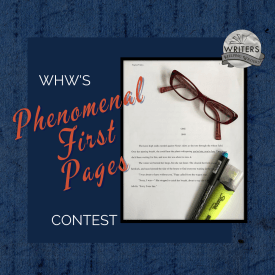 Hey, wonderful writerly people! It���s time for our monthly first-page critique contest..with a holiday twist!
Hey, wonderful writerly people! It���s time for our monthly first-page critique contest..with a holiday twist!We appreciate every one of you so much. We love seeing you win prizes and hope critiques like these help take your writing to the next level. But some people read our blog regularly, leave tons of contest comments, and haven’t won. That’s not fair! So our holiday gift is to choose three people who have participated the most, but haven’t won this past year.

Pssst…we plan to do this again in the future, so every contest comment counts (including this post).
We’re grateful for all of you and would love to give everyone a present. In case you missed it, here’s a gift from Angela and me: a webinar called Secrets to Engaging Readers. Enjoy!
The first page critique winners are…BeckyKendra
Wendy
Congrats! Mindy will send you an e-mail with instructions to receive your first page critique from me.
We run this contest on a monthly basis and will be back to randomly selecting winners next month. If you���d like to be notified when the next opportunity comes around, consider subscribing to our blog (see the right-hand sidebar).��
You don’t want to miss the January contest! It has three HUGE prizes from a guest editor…including a peek at a synopsis (a rough synopsis is fine if you don’t have a polished one). This is great motivation to work on one.
Happy holidays! One of the best gifts we can give ourselves is celebrating our accomplishments. We often cheer for big milestones like selling a book, signing with an agent and winning awards–but we also need to celebrate items that are often overlooked. Finishing a manuscript. Having an ‘aha’ moment. Trying a new genre. Gaining new writing tools. They’re incredibly important, too.
We’d love to cheer on your 2022 successes in the comments. PS: If you want to amp up your first page, grab our helpful First Pages checklist from One Stop for Writers. And for more instruction on these important opening elements, see this Mother Lode of First Page Resources.The post Phenomenal First Pages Contest: Holiday Edition 2022 appeared first on WRITERS HELPING WRITERS��.
December 17, 2022
Fear Thesaurus Entry: Being Physically Touched
Debilitating fears are a problem for everyone, an unfortunate part of the human experience. Whether they’re a result of learned behavior as a child, are related to a mental health condition, or stem from a past wounding event, these fears influence a character’s behaviors, habits, beliefs, and personality traits. The compulsion to avoid what they fear will drive characters away from certain people, events, and situations and hold them back in life.
In your story, this primary fear (or group of fears) will constantly challenge the goal the character is pursuing, tempting them to retreat, settle, and give up on what they want most. Because this fear must be addressed for them to achieve success, balance, and fulfillment, it plays a pivotal part in both character arc and the overall story.
This thesaurus explores the various fears that might be plaguing your character. Use it to understand and utilize fears to fully develop your characters and steer them through their story arc. Please note that this isn’t a self-diagnosis tool. Fears are common in the real world, and while we may at times share similar tendencies as characters, the entry below is for fiction writing purposes only.
 Fear of Being Touched
Fear of Being TouchedNotes
While many people are sensitive to physical contact, an actual fear of being touched can lead to a host of difficulties. It can come about from a past trauma, learned experiences (through growing up in a family where touch was discouraged or punished), a physical sensitivity, or a mental health condition, to name just a few possible causes.
What It Looks Like
Backing away from handshakes, kisses, or other cultural greetings
Sticking to the fringes of crowds
Avoiding romantic relationships
Not eating certain foods due to their texture��
Not participating in contact sports, dancing, and other activities that require touch
Difficulty making new friends
Only being able to wear certain kinds of clothing that don’t chafe or irritate the skin
The character keeping their hands in their pockets
Flinching away from physical contact
Stiffening when hugged or patted
Being comfortable with touch from a select few people
Becoming irritated when they’re hugged or touched without consent
The character wearing a badge or sticker that tells people they’re not comfortable being hugged
Sticking close to people who know the character and respect their boundaries
Avoiding doctors and dentists
Common Internal Struggles
The character feeling uncomfortable when their personal space is invaded
Desiring sex or other forms of intimacy but being unable to endure the physical contact
Distrusting men or women (if this was part of a traumatizing event that spawned the fear)
Wishing they could be “normal” like other people
Wanting to attend a crowded event but being unable to do so
Feeling uncomfortable in their own skin
Struggling with shame or self-loathing because of their affliction
Flaws That May Emerge
Abrasive, Antisocial, Compulsive, Disrespectful, Fussy, Hostile, Obsessive, Tactless, Temperamental, Timid, Withdrawn
Hindrances and Disruptions to the Character’s Life
Having just a small circle of friends or loved ones
Having panic attacks at the thought of being touched sexually
Constantly feeling “othered” because people think the character is weird
Not being able to hug their children, parents, or other loved ones
Suffering through medical difficulties because the character won’t see a doctor
Being constantly misunderstood because others assume the character is standoffish or unfriendly
Enduring daily physical discomfort
Scenarios That Might Awaken This Fear
Getting into a relationship with someone whose love language is physical touch
Having to visit a doctor
Getting caught in a crowd
An unwanted sexual advance
Being attacked or assaulted
Another character becoming offended when their attempts at affection are rebuffed
Family members expecting a hug or kiss
Being given an opportunity that requires the character to step out of their physical comfort zone
Other Fear Thesaurus entries can be found here.
 Need More Descriptive Help?
Need More Descriptive Help?While this thesaurus is still being developed, the rest of our descriptive collection (16 unique thesauri and growing) is accessible through the One Stop for Writers THESAURUS database.
If you like, swing by and check out the video walkthrough for this site, and then give our Free Trial a spin.
The post Fear Thesaurus Entry: Being Physically Touched appeared first on WRITERS HELPING WRITERS��.
Writers Helping Writers
- Angela Ackerman's profile
- 1022 followers



